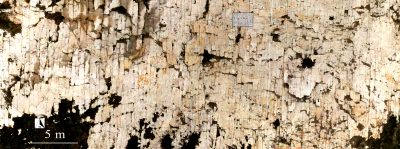Brittle fracture characterization has been a vexing problem for decades. Great advances have come from the field, the laboratory and numerical modeling, yet it is still challenging to adequately predict fracture attributes that impact fluid flow and macroscopic mechanical behavior any appreciable distance away from control data from wells or outcrops. In fact, the data collected from accessible rock volumes is often incomplete and may not sufficiently constrain attributes of interest to solve engineering or scientific problems.

Fracture pattern
In this presentation, I want to review some things learned by applying elastic fracture mechanics and the subcritical crack growth mechanism to the problem of brittle opening mode fracture pattern development in layered rocks and discuss how modeling results compare to field observations.
Sub-linear scaling of aperture vs length data from mesoscale veins (cm to meter length scale) suggest that brittle crack growth is controlled by scale-independent fracture strength. The mechanical influence of layer confinement on fracture opening also promotes sub-linear aperture/length scaling. Mechanical crack interaction dictates fracture planarity and spacing in a complex way, influenced by strain rate, subcritical crack index, mechanical layer thickness and stress anisotropy.
Modeling results suggest crack length distribution shape can range from negative exponential to power-law based on pattern geometry (single parallel set vs simultaneous orthogonal development). Field observations have demonstrated aperture population statistics commonly follow power-law distributions in brittle fractures exhibiting crack-seal textures and other attributes of coeval crack opening and cement precipitation.
Mechanical modeling has yet to adequately reproduce such distributions, but coupling mechanics and diagenesis shows promising results.
Jon E. Olson
Presented at AGU Fall Meeting 2021, held in New Orleans, LA, 13-17 December 2021, id. EP54B-07
Related papers:
Lee, B., Olson, J.E., & Laubach, S.E., 2022. Coupling diagenesis and mechanics for more realistic simulation of natural fracture pattern development, Extended Abstract, Second International Meeting for Applied Geoscience & Energy, AAPG IMAGE 2022. | view at publisher
Laubach, S.E., Lander, R.H., Criscenti, L.J., et al., 2019. The role of chemistry in fracture pattern development and opportunities to advance interpretations of geological materials. Reviews of Geophysics, 57 (3), 1065-1111. doi:10.1029/2019RG000671 | view at publisher | blog post | BEG summary | view AGU Editor’s Vox | JSG press release
© 2025 Jackson School of Geosciences, The University of Texas at Austin


